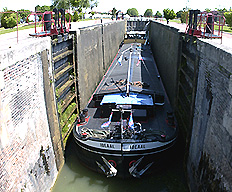
ATIS and RAINWAT
Automatic Transmitter Identification System (ATIS) is required for vessels making VHF transmissions whilst on the inland waterways of the Regional Arrangement Concerning the Radiotelephone Service on Inland Waterways (RAINWAT)signatory countries.
RAINWAT is the "Regional Arrangement Concerning the Radiotelephone Service on Inland Waterways". It is an agreement to implement common principles and rules for the safe carriage of people and goods on Inland Waterways. The signatory countries are: Austria, Belgium, Bulgaria, Croatia, the Czech Republic, France, Germany, Hungary, Luxembourg, Moldova, Montenegro, the Netherlands, Poland, Romania, Serbia, the Slovak Republic and Switzerland.
Where a VHF is required on the inland waterways of the signatory countries, this must be capable of Automatic Transmitter Identification System (ATIS) transmissions, and have the feature activated. An ATIS number is required which is issued by Ofcom as a Notice of Variation to the Ship Radio Licence. This must be done manually, by Ofcom, until such time as changes to the Ofcom licensing system are made to automate the process. The turnaround time at Ofcom will increase in line with the number of requests received, however even if this is only a few days applicants must allow up to a month for Ofcom to supply details of the vessel to the Belgian regulator, BIPT, which oversees the ATIS database and for the BIPT database to reflect updates that are sent to it.
A copy of the Regional Arrangment should be carried on board. This can be downloaded from the RAINWAT web-site.
Ofcom has provided a comprehensive explanation of ATIS and RAINWAT on their web-site, which explains what ATIS is, how it works and the action you need to take prior to venturing onto the inland waterways of the signatory countries including how to request the Notice of Variation to your Ship Radio Licence and thereby the ATIS number for your vessel.
It is important to note that under the Notice to Variation of the Ship Radio Licence, ATIS shall not be used within 14 nautical miles of the low waterline around the coast of the UK, the Isle of Man and the Channel Islands.
The use of DSC (VHF Ch. 70) is in most countries restricted to coastal waters and DSC transmissions should not be made when navigating the inland waterways.
Not all VHF sets are capable of ATIS transmissions; you may need to contact your manufacturer for advice.
Elsewhere on the web
Official advice on ATIS from OFCOM
The official web-site